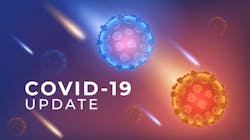ADA answers questions on COVID-19 in press conference for dental media
Editor's note: This article was updated May 17, 2020, to clarify ADA recommendations and May 18, 2020, to provide further information on reusing N95 masks reusage.
These are without a doubt unprecedented times for our generation of dental professionals. In response to these circumstances, Lou Shuman, DMD, CAGS, president and CEO of Cellerant Consulting Group, orchestrated a meeting on Friday between the leadership of the American Dental Association (ADA) and members of the dental media. In a 90-minute video conference, Dr. Shuman moderated a discussion that was intended to provide clarity and insight into the current situation. I was honored to attend the meeting.
In this article, I'll review the press conference and highlight key details that have not fully made their way to the general dental community.
Opening statements
To open the meeting, Dr. Shuman accurately described the magnitude of the situation. "We currently face one of the most serious challenges in our lifetime," he said. "It is [impacting] our health, our lives, and the lives of our families and friends...our way of life, our economy, our own finances, and our profession. [...] How do we define 'safe' and how do we get clarity when there is so much noise?”
The president of the ADA, Chad Gehani, DDS, spoke first. He gave an overview of the pandemic timeline and discussed actions the ADA had taken. The ADA, Dr. Gehani said, had met with scientists, epidemiologists, and experts in every field. After doing so, the association made the difficult decision to recommend that dentists refrain from elective procedures. The decision was made in order to:
- conserve PPE;
- reduce the number of patients going into emergency rooms; and
- mitigate the spread of SARS-CoV-2, the virus responsible for COVID-19.
The ADA's recommendation to postpone all but urgent/emergency procedures ended on April 30, 2020, and was not renewed. As of today, the ADA advises that dentists follow state and local mandates. Not all states are open yet, but in those states that have or are in the process of reopening, the ADA's Return to Work Interim Guidance Toolkit is a science-based resource for dentists.
Dr. Gehani said the ADA will continue their advocacy efforts and update their resources and recommendations as new information comes to light. He further stated that the Return to Work Interim Guidance Toolkit has had over 100,000 downloads, and that it is a comprehensive yet evolving tool to aid dental practices that are preparing to resume elective patient care.
Takeaways from the Q&A session
The floor was then opened for questions. The following topics were covered: liability, the dentist–dental hygienist relationship, support for dentists, public perception, the ADA’s response, testing, and PPE. The ADA gave us their perspective of each issue. Some responses to the questions were predictable, but some interesting and new information was offered. Here are some key takeaways:
- CDC guidance—The CDC is updating their guidance for dental settings. This information may be available as early as the week of May 18, 2020.
- PPE shortage—The reason it is so difficult for us to secure PPE is that hospitals, long-term care facilities, and first responders are given priority by the federal government to obtain PPE. The ADA acknowledged our frustrations with obtaining PPE and stated that there is a significant increase in production in the works. By July 2020, there should be enough N95 masks for dental practices. In the meantime, disinfecting N95 masks with a 1.0–1.5% aerosolized hydrogen peroxide will extend the lifespan of a mask by three times. (For more information, see the CDC's page titled, Recommended Guidance for Extended Use and Limited Reuse of N95 Filtering Facepiece Respirators in Healthcare Settings.)
- Point-of-care testing—The ADA is lobbying for dentists to be able to prescribe and perform point-of-care testing for COVID-19. Before a formal recommendation will be made, there must be enough science and it must be practical for dentists to offer tests in their offices. Additionally, the use of gray market testing was cautioned: there are currently only 11 tests that have Emergency Use Authorization from the Food and Drug Administration.
- Difficult choices—The ADA expressed concern for all dentists and members of the dental team during this unprecedented time. Members of the ADA leadership said the recommendation to cease elective dental care was made after careful deliberation. Moreover, the dentists who have been financially impacted the most are new graduates and non-owner dentists. As practices reopen, the ADA urges practice owners to adhere to CDC guidelines and state and local mandates. The economic recovery of dental practices will be continually monitored and projections will be updated. States that have reopened will be continually monitored for the resurgence of COVID-19 and affect future recommendations.
- Communication—To address public concerns regarding the safety of dental procedures, the ADA has been a part of 2,300 news stories, been active on social media, and has provided an online resource for patients. According to the ADA, it appears that, generally speaking, the public doesn’t feel unsafe in returning to dental practices. The top reason that people will be avoiding dentists is economic circumstances.
- Lobbying—The ADA will continue their advocacy for dentists to obtain economic support and will continually monitor the impact of COVID-19 on dental practices.
Where we go from here
I would like to acknowledge Dr. Gehani and the ADA executive team for listening and responding to the concerns of the dental community. It is my hope that this is the beginning of open and candid communications between the ADA and the dental media. I would also like to acknowledge Dr. Lou Shuman and his concern for the dental community. It is heart-warming and inspiring.
While it may never be scientifically proven that the prolonged closure of dental practices resulted in the mitigation of the spread of COVID-19 in our respective communities, I agree with Dr. Gehani: We will get through this.
Pamela Maragliano-Muniz, DMD, is the chief editor of DentistryIQ. Based in Salem, Massachusetts, Dr. Maragliano-Muniz began her clinical career as a dental hygienist. She went on to attend Tufts University School of Dental Medicine, where she earned her doctorate in dental medicine. She then attended the University of California, Los Angeles, School of Dental Medicine, where she became board-certified in prosthodontics. Dr. Maragliano-Muniz owns a private practice, Salem Dental Arts, and lectures on a variety of clinical topics.
Editor's note: For full coverage of the coronavirus pandemic, visit the DentistryIQ COVID-19 Resource Center.
Related
- ADA asks CDC to change dental guidance on COVID-19
- Confusion about reopening due to lack of CDC guidance
Recommended
About the Author

Pamela Maragliano, DMD
Pamela Maragliano, DMD, is the chief editor of Dental Economics. Based in Salem, Massachusetts, Dr. Maragliano began her clinical career as a dental hygienist. She went on to attend Tufts University School of Dental Medicine, where she earned her doctorate in dental medicine. She then attended the University of California, Los Angeles, School of Dental Medicine, where she became board-certified in prosthodontics. Dr. Maragliano owns a private practice, Salem Dental Arts, and lectures on a variety of clinical topics. You may contact her at [email protected].
